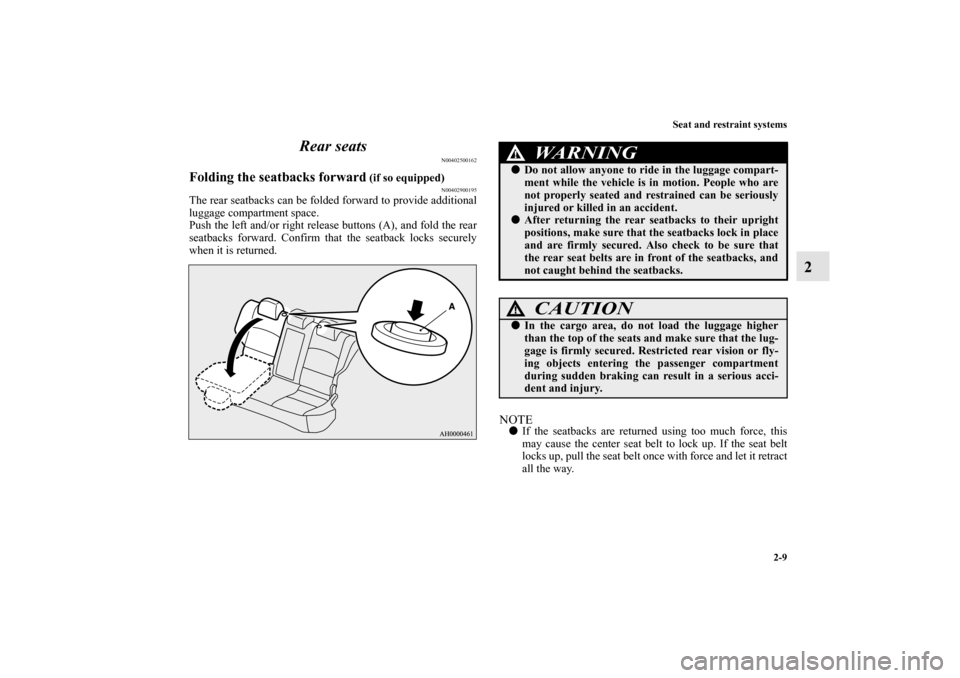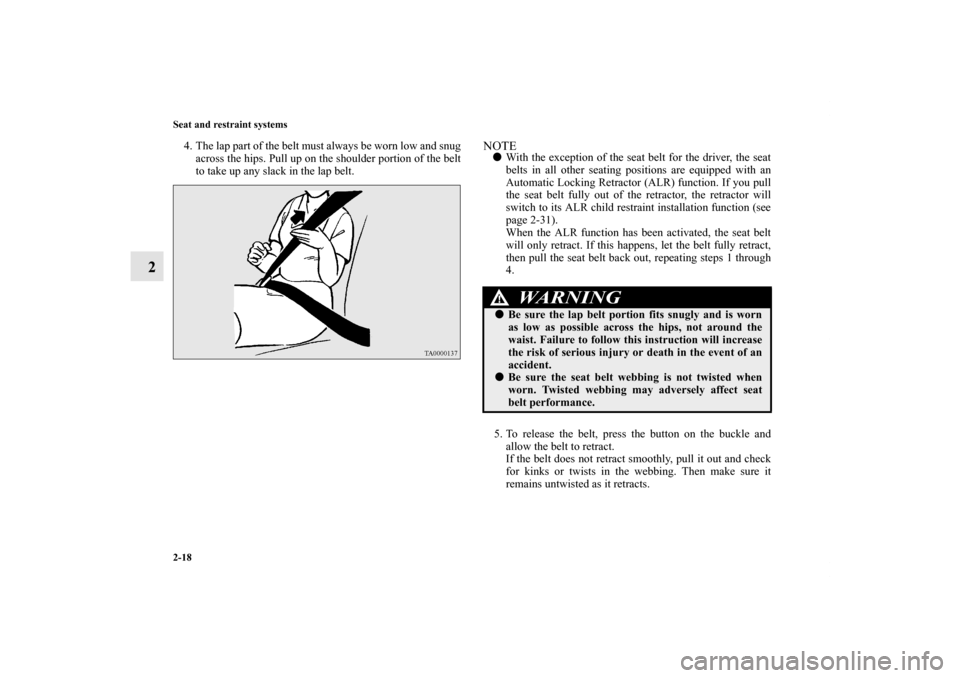Page 42 of 722

Seat and restraint systems
2-9
2 Rear seats
N00402500162
Folding the seatbacks forward
(if so equipped)
N00402900195
The rear seatbacks can be folded forward to provide additional
luggage compartment space.
Push the left and/or right release buttons (A), and fold the rear
seatbacks forward. Confirm that the seatback locks securely
when it is returned.
NOTE�If the seatbacks are returned using too much force, this
may cause the center seat belt to lock up. If the seat belt
locks up, pull the seat belt once with force and let it retract
all the way.
WA R N I N G
!�Do not allow anyone to ride in the luggage compart-
ment while the vehicle is in motion. People who are
not properly seated and restrained can be seriously
injured or killed in an accident.�After returning the rear seatbacks to their upright
positions, make sure that the seatbacks lock in place
and are firmly secured. Also check to be sure that
the rear seat belts are in front of the seatbacks, and
not caught behind the seatbacks.
CAUTION
!�In the cargo area, do not load the luggage higher
than the top of the seats and make sure that the lug-
gage is firmly secured. Restricted rear vision or fly-
ing objects entering the passenger compartment
during sudden braking can result in a serious acci-
dent and injury.
BK0150800US.book 9 ページ 2012年3月29日 木曜日 午後2時38分
Page 47 of 722

2-14 Seat and restraint systems
2Seat belts
N00406000439
Seat belts are installed in your vehicle to help reduce the risk of
injury to the driver and passenger in the event of an accident.
Always use the provided seat belts.
Carefully review the following information for proper seat belt
usage.
WA R N I N G
!�In order to minimize the risk of a neck injury due to
a rear impact, the driver and front passenger seat-
backs must be adjusted to the upright position
before vehicle operation. The driver should never
adjust the seat while the vehicle is in motion.�Never place a cushion or similar device on the seat-
back. This can adversely affect head restraint per-
formance by increasing the distance between your
head and the restraint.
WA R N I N G
!�To help reduce the risk of injury or death in an acci-
dent, seat belts and child restraint systems must
always be used. Refer to “Child restraint systems”
on page 2-24 for additional information.�Never use one seat belt for more than one person. �Never carry more people in your vehicle than there
are seat belts.�Always adjust the seat belt for a snug fit.�Always place the shoulder belt over your shoulder
and across your chest. Never put it behind you or
under your arm. �Always wear the lap belt as low as possible across
your hips, not around your waist.�Never modify or alter the seat belts in your vehicle.�To reduce the risk to the driver of serious injury or
death during deployment of the driver’s airbag,
always properly wear the seat belt and adjust the
driver’s seat as far back as possible while maintain-
ing a position that still enables you to fully apply the
pedals, easily control the steering wheel, and safely
operate the vehicle.
BK0150800US.book 14 ページ 2012年3月29日 木曜日 午後2時38分
Page 48 of 722

Seat and restraint systems
2-15
2
Seat belt instructions
N00406200402
All seats are equipped with a seat belt which uses one com-
bined lap-and-shoulder belt with an emergency locking retrac-
tor.
This system is designed to provide both comfort and safety. It
permits full extension and automatic retraction of the belts dur-
ing normal vehicle operation. A sensing device inside the belt
retractor is designed to lock the retractor in the event of a sud-
den change in the vehicle’s motion.NOTE�For instructions on installing a child restraint system using
a seat belt, refer to “Installing a child restraint system
using the seat belt” on page 2-31.
�To reduce the risk to a front seat passenger of seri-
ous injury or death from a deploying airbag, make
sure the passenger always wears the seat belt prop-
erly, remains seated all the way back and upright in
their seat, and moves the seat as far back as possible.
Refer to “Supplemental Restraint System (SRS) -
airbag” on page 2-35 for additional information.�Never hold an infant or child in your arms or on
your lap when riding in this vehicle even when you
are wearing your seat belt. Never place any part of
the seat belt you are wearing around an infant or
child. Failure to follow these simple instructions cre-
ates a risk of serious injury or death to your child in
the event of an accident or sudden stop.�Children 12 years old and under should always ride
in the rear seat and be properly restrained. This
reduces their risk of serious injury or death in an
accident, especially due to a deploying front passen-
ger airbag. Refer to “Child restraint systems” on
page 2-24 for additional information.�Any child who is too small to properly wear a seat
belt must be properly restrained in an appropriate
child restraint system. Children 12 years old and
under should be seated only in the rear seat to
reduce their risk of serious injury or death in an
accident, especially from the deployment of a front
passenger airbag.�Infants MUST be placed in a rear-facing child safety
seat and positioned in the rear seat.
WA R N I N G
!
�In the event of an accident, all seat belt assemblies,
including retractors and attachment hardware,
should be inspected by an authorized Mitsubishi
Motors dealer to determine whether replacement is
necessary.
WA R N I N G
!
BK0150800US.book 15 ページ 2012年3月29日 木曜日 午後2時38分
Page 49 of 722

2-16 Seat and restraint systems
2
1. Occupants should always sit back in their seats with their
backs against the upright seatback. To reduce the risk of
serious injury or death during deployment of the airbag,
adjust the driver’s seat as far back as possible while main-
taining a position that still enables you to fully apply the
pedals, easily control the steering wheel, and safely oper-
ate the vehicle. The front passenger seat should also be
moved as far back as possible. Refer to “Supplemental
Restraint System (SRS) - airbag” on page 2-35. Also refer
to “To adjust the seat forward or backward” on page 2-5.
WA R N I N G
!�To reduce the risk of serious injury or death in the
event of an accident or sudden stop, all seatbacks
should be kept in the upright position while the vehi-
cle is in motion.
Seat belt performance during an accident can be
adversely affected if the seatbacks are reclined. The
more a seatback is reclined, the more likely seat belt
performance will be adversely affected. If the seat
belt is not properly positioned against the body dur-
ing an accident, there is increased risk you will slide
under the belt and receive serious injury or death.
BK0150800US.book 16 ページ 2012年3月29日 木曜日 午後2時38分
Page 50 of 722
Seat and restraint systems
2-17
2
2. Grasp the latch plate and slide it up the webbing so that it
easily pulls across your body. 3. Pull the seat belt out slowly while holding the latch plate.
Push the latch plate into the buckle until you hear a
“click”. Pull up on the belt to be sure the latch plate is
locked securely in the buckle.
NOTE�If the seat belt locks up and cannot be pulled out, pull it
once with force and let it retract all the way.
Then, pull the belt out slowly once again.
BK0150800US.book 17 ページ 2012年3月29日 木曜日 午後2時38分
Page 51 of 722

2-18 Seat and restraint systems
2
4. The lap part of the belt must always be worn low and snug
across the hips. Pull up on the shoulder portion of the belt
to take up any slack in the lap belt.
NOTE�With the exception of the seat belt for the driver, the seat
belts in all other seating positions are equipped with an
Automatic Locking Retractor (ALR) function. If you pull
the seat belt fully out of the retractor, the retractor will
switch to its ALR child restraint installation function (see
page 2-31).
When the ALR function has been activated, the seat belt
will only retract. If this happens, let the belt fully retract,
then pull the seat belt back out, repeating steps 1 through
4.
5. To release the belt, press the button on the buckle and
allow the belt to retract.
If the belt does not retract smoothly, pull it out and check
for kinks or twists in the webbing. Then make sure it
remains untwisted as it retracts.
WA R N I N G
!�Be sure the lap belt portion fits snugly and is worn
as low as possible across the hips, not around the
waist. Failure to follow this instruction will increase
the risk of serious injury or death in the event of an
accident.�Be sure the seat belt webbing is not twisted when
worn. Twisted webbing may adversely affect seat
belt performance.
BK0150800US.book 18 ページ 2012年3月29日 木曜日 午後2時38分
Page 52 of 722

Seat and restraint systems
2-19
2
Driver’s seat belt reminder/warning light and
display
N00418400300
Warning light
Warning display type 1
Warning display type 2
A tone and warning light are used to remind the driver to fasten
the seat belt.
If the ignition switch is set to the “ON” position without the
driver’s seat belt being fastened, a warning light will come on
and a tone will sound for approximately 6 seconds to remind
you to fasten your seat belt.
If you then drive with the seat belt unfastened for longer than a
minute from when the ignition switch was turned on, the warn-
ing light will come on and blink repeatedly and the tone will
sound intermittently.
The warning light and the tone will stop after approximately 90
seconds.If you then repeatedly stop and start your vehicle with the seat
belt unfastened, the warning light/display and tone will remind
you to fasten your seat belt every time the vehicle starts mov-
ing. You will also be reminded to fasten your seat belt in this
way when you remove your seat belt while driving. The warn-
ing light and the tone go off when the seat belt is fastened.
NOTE�At the same time, “FASTEN SEAT BELT” will be dis-
played on the information screen in the multi-information
display.
WA R N I N G
!�In order to reduce the risk of serious injury or death
in an accident, always wear your own seat belt. Do
not allow anyone to ride in your vehicle unless he or
she is also seated and wearing a seat belt. Children
should additionally be restrained in a secure child
restraint system.
BK0150800US.book 19 ページ 2012年3月29日 木曜日 午後2時38分
Page 53 of 722
2-20 Seat and restraint systems
2
Front passenger seat belt warning light
N00418300165
The front passenger seat belt warning light is located in the
instrument panel.
When the key is turned to the “ON” position, this indicator nor-
mally comes on and goes off a few seconds later.
The light comes on when a person sits on the front passenger
seat but does not fasten the seat belt. It goes off when the seat
belt is subsequently fastened.
Adjustable seat belt shoulder anchor (front seats)
N00406300315
To move the anchor down, press the lock knob (A) and slide
the anchor down to the desired position.
To move the anchor up, slide the anchor up to the desired posi-
tion.
WA R N I N G
!�Do not install any accessory or sticker that makes
the light difficult to see.
Anchor down Anchor up
BK0150800US.book 20 ページ 2012年3月29日 木曜日 午後2時38分